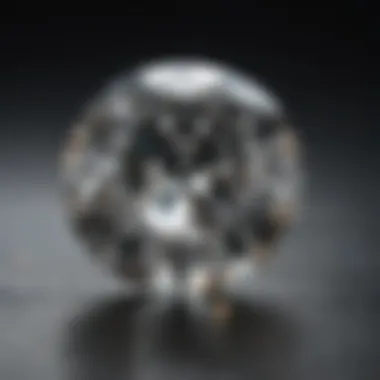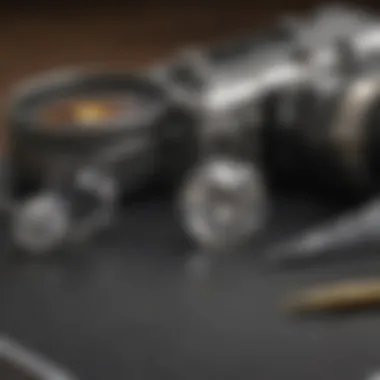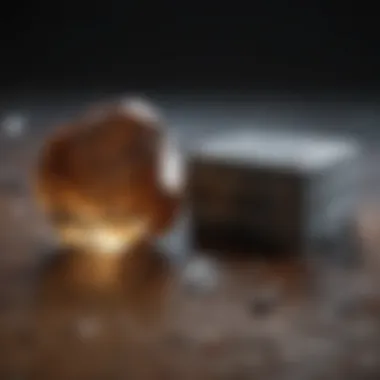Exploring the Diamond Hardness Test: Methods and Implications


Intro
Diamond, often revered for its brilliance and allure, is not solely a symbol of luxury. Its hardness plays a pivotal role in various fields, making it essential for evaluation in gemology and materials science. Understanding how to measure this hardness allows professionals and enthusiasts alike to assess both the quality of diamonds and their potential uses in industrial applications. The diamond hardness test encompasses several methods, each with its own significance, advantages, and limitations. This article intends to provide a thorough exploration into these testing methods, shedding light on how they impact the understanding of diamonds.
Featured Collectible of the Month
Overview
Each month, a select diamond specimen is highlighted, providing clarity on the unique characteristics that caught the attention of collectors and gemologists. This month, we delve into the "Pink Star", a famous diamond renowned for its hue and quality. This diamond's hardness is part of its mystique, as it is evaluated not only for its aesthetic appeal but also for its structural integrity.
Historical Significance
The Pink Star represents more than just beauty. Discovered in South Africa, its provenance has intrigued collectors. Diamonds like the Pink Star must meet rigorous standards regarding their hardness, a measure deeply embedded in their history of ownership, trade, and valuation. This integration of hardness testing into the narrative of renowned diamonds showcases the multifaceted nature of gemology.
Identification Techniques
Identifying a diamond involves numerous techniques beyond mere visual appraisal.
Visual Characteristics
To the untrained eye, distinguishing between natural diamonds and synthetics can be challenging. However, experts often rely on specific visual cues:
- Clarity: Natural diamonds may exhibit inclusions, while synthetics typically display fewer imperfections.
- Cut Quality: A well-cut diamond refracts light differently, impacting perceived brilliance.
- Color: While most natural diamonds are colorless, some feature hues that point toward their unique qualities.
Resources for Identification
For individuals aiming to explore their collections or delve deeper into the world of diamonds, several resources are invaluable:
- GIA (Gemological Institute of America): GIA Website
- International Gem Society: IGS Website
- Wikipedia's page on Diamonds: Wikipedia
"The hardness of a diamond not only defines its physical attributes but also intertwines with its historical and commercial significance."
By grasping both diamond hardness testing methods and their implications, collectors can enhance their understanding of what makes each specimen unique. Whether you are a novice or an expert, the relevance of diamond hardness extends to practical applications, guiding decisions in buying, selling, or simply appreciating these exquisite gemstones.
Preamble to Diamond Hardness
Understanding diamond hardness is central to both gemology and materials science. Diamonds, known for their remarkable durability, are rated on their hardness to determine their suitability for various applications. The hardness of a diamond has implications that extend beyond aesthetics; it affects market value, industrial usage, and even scientific research.
The way diamonds are assessed for hardness can greatly influence their perceived value. Collectors and enthusiasts often seek reliable information concerning hardness tests. Differences in testing methods can lead to variations in results, making it vital for stakeholders to grasp the nuances that these techniques introduce. This understanding can serve as a bridge to facilitate informed decision-making when evaluating diamonds for purchase or further exploration.
Understanding Diamond Composition
Diamonds are composed of carbon atoms arranged in a crystal lattice structure. This unique formation contributes to their overall hardness, which is the highest among all known natural materials. The arrangement of atoms allows diamonds to withstand significant pressure and resist scratching. Knowledge of diamond composition is essential to appreciate why they possess such impressive durability.
The production process of diamonds, whether natural or synthetic, can influence their integrity. Natural diamonds form deep within the Earth's mantle over millions of years, whereas synthetic diamonds are created in controlled environments. Each type presents different characteristics that may affect hardness, thus adding complexity to assessments.
The Role of Hardness in Gemology
In gemology, hardness is a crucial factor in determining a gem's quality, care, and usability. A higher hardness rating means a gem can better withstand wear and tear, making it suitable for everyday wear in jewelry. For instance, diamonds are often favored for engagement rings and other pieces due to their ability to maintain appearance over time.
Moreover, the hardness of a gemstone influences the ways it can be crafted and polished. Jewelers often consider hardness when setting diamonds in metal settings. Knowledge of hardness ensures that the selection of materials is appropriate, protecting the gem from potential damage.
Hardness testing is not merely academic; it has practical applications that impact both the marketplace and the gemology community. The results from hardness tests significantly affect buying decisions, pricing, and perceptions of value within both commercial and collector contexts.
Significance of the Hardness Test


Understanding the significance of diamond hardness tests is crucial for several reasons. Firstly, these tests provide insights into the durability and performance of diamonds in various applications. This goes beyond mere gemstone qualities. It extends into understanding how diamonds are used in cutting tools and industrial applications, where hardness plays a vital role. The hardness of a diamond indicates its resistance to scratching and wear, which is particularly important in both commercial and industrial contexts.
Moreover, these tests influence the gemological evaluation of diamonds. High hardness enhances the desirability of a diamond, impacting its market value. Industry professionals use hardness measurements to assess the quality of a diamond effectively. Thus, the results of these tests hold significant implications for pricing and consumer choice. The economic impact of hardness assessments is evident, as these grades can determine the profit margins in various sectors.
Evaluating hardness also allows for comparisons among different gemstones. This not only aids collectors and consumers in making informed selections but also supports jewelers and manufacturers in sourcing the right materials for specific needs. Here, the practical implications of hardness assessments extend beyond aesthetics and into functionality.
Furthermore, understanding the limitations and variability in testing methods is also significant. Different testing methodologies can yield varying results, which might confuse non-experts. Therefore, clarity in results and methodology ensures that informed decisions are made based on reliable data.
"The hardness of a diamond vividly illustrates its unique properties within both geological and industrial frameworks."
Applications in Industry
Diamond hardness tests have numerous applications in industry. First, diamonds are widely recognized for their use in cutting, grinding, and drilling tools due to their hardness. For example, diamond-tipped drill bits are employed in mining and oil extraction, offering precision and longevity. These tools benefit from the testing of diamond hardness to ensure they meet performance standards required in heavy-duty applications.
In addition to tools, diamonds serve various functions in electronics and optics. For instance, specific diamond coatings are utilized in making circuit boards. Here, hardness assessments ensure that the material can withstand the rigors of the manufacturing process without degradation.
Another significant application is in the production of jewelry. In this sector, the hardness of diamonds is essential for maintaining the quality and integrity of gemstone settings. Consumers also favor harder diamonds for their durability in everyday wear, which raises their market appeal.
Thus, the applications in industry highlight the multifaceted significance of diamond hardness tests, revealing their critical role in enhancing manufacturing processes and consumer products.
Impact on Value Assessment
The impact of diamond hardness on value assessment cannot be understated. Hardness serves as an important criterion for determining the quality of diamonds. Higher hardness typically signifies superior durability, which boosts desirability and, consequently, market price. Consumers often perceive harder diamonds as more valuable, leading to higher bidding in auctions and retail settings.
Experts and appraisers utilize hardness data to place a value on diamonds, integrating this aspect with other characteristics like cut, color, and clarity. This multifactorial assessment enables a comprehensive evaluation of a diamond’s worth in the marketplace.
Moreover, the emergence of synthetic diamonds presents an interesting challenge. As these materials grow in popularity, hardness assessments play an essential role in distinguishing them from natural stones. This has implications for pricing and market strategies in the gem industry, reshaping how value is perceived based on hardness and other properties.
In summary, the influence of diamond hardness on market value reflects a broader trend of quality assessment in the gemstone industry. This emphasizes the necessity for accurate and reliable hardness testing methods, ensuring transparency for both consumers and industry players.
Methods of Testing Diamond Hardness
The evaluation of diamond hardness is central to both gemology and materials science. The accuracy of testing methods directly impacts the assessment of a diamond's suitability for various applications. Each method has its own set of advantages and limitations, contributing to the overall understanding of a diamond's properties. Knowing these methods can help gem aficionados and industry professionals make informed decisions.
Mohs Hardness Scale Overview
The Mohs hardness scale is one of the oldest and simplest methods for assessing mineral hardness. Developed in 1812 by Friedrich Mohs, this scale ranks minerals from 1 (talc) to 10 (diamond). Diamonds sit at the top due to their exceptional hardness. The scale is based on the ability of one mineral to scratch another.
To use the Mohs scale, a collector tests the diamond against standard minerals. For instance, if a diamond can scratch quartz (which has a hardness of 7), it is clearly very hard. However, this method has limitations. The scale does not provide precise numerical values, making it less useful for scientific applications.
Vickers Hardness Test Methodology
The Vickers hardness test employs a diamond indenter, showcasing diamonds' unique structural characteristics. This method measures hardness based on the size of an indentation left by a diamond in a material. The process begins by applying a specific load, usually between 1 kg and 100 kg, for a standardized time. After removing the load, the dimensions of the indentation are measured.
The calculation of Vickers hardness involves the load divided by the surface area of the indentation. This yields a more precise value, thus making the Vickers test widely accepted in both gemology and industry. It allows experts to compare hardness across different materials, contributing to the diamond's perceived value.
Brinell Hardness Testing Explained
The Brinell hardness test is another common approach, suitable for larger and more heterogeneous materials. In this method, a hardened steel or carbide ball is pressed into the material's surface under a specific load. The diameter of the indentation provides the necessary data to calculate hardness. The Brinell test is particularly relevant for assessing the hardness of diamond-tipped tools.
While this method is effective, it can be more difficult to apply directly to small gemstones due to size constraints. Nevertheless, its significance in industrial applications cannot be overstated. The Brinell test offers a practical solution for measuring the hardness of products utilized in manufacturing.
Knoop Hardness Test Specifics
The Knoop hardness test is particularly useful for testing brittle materials like diamond. It uses an elongated diamond indenter, creating a long, narrow indentation. This method allows for testing a tiny volume of material and is perfect for small stones and gems.
After the load is removed, technicians measure the length of the indentation. The Knoop hardness number is calculated using the diagonal lengths of the indentation and the force applied. This method is advantageous in research and quality control settings, providing detailed information about the hardness of diamonds without damaging them extensively.


"The Knoop hardness test allows for precise measurements on a microscopic scale, making it ideal for delicate gems."
In summary, understanding these various testing methods is essential for anyone involved in the domain of diamonds. Each method provides a different perspective on a diamond's durability, making it possible to assess its practical applications and market value.
Comparative Analysis of Testing Methods
The importance of conducting a comparative analysis of the different methods for testing diamond hardness cannot be understated. Each method yields distinct insights into the material properties of diamonds. Understanding these differences guides gemologists and industrial manufacturers in selecting the most suitable approach for their specific needs. This section focuses on the inherent attributes of the most common hardness testing methods, their advantages, and the limitations associated with each test.
Advantages of Each Method
Different hardness testing methods serve various purposes based on their unique advantages. Here are some notable benefits:
- Mohs Hardness Scale: This method is straightforward and cost-effective. It provides a quick reference for the scratch resistance of materials, making it useful for gemologists during field examinations.
- Vickers Hardness Test: The Vickers method's advantage lies in its versatility. It can test materials of varying hardness, including diamonds. Its ability to provide detailed micro-hardness measurements is particularly beneficial for precision applications in industry.
- Brinell Hardness Test: This test is suitable for larger samples due to its depth of penetration, allowing for effective testing of metals and certain industrial tools. The results offer a broader overview of hardness in bulk materials.
- Knoop Hardness Test: Knoop is ideal for fragile materials or thin layers. It applies a lower load, thus minimizing the risk of damaging the sample while providing accurate and meaningful results.
Each method has distinct strengths that make it appropriate under specific circumstances, whether in gemology or industrial applications. Understanding these advantages aids individuals in making informed decisions.
Limitations and Considerations
Despite their advantages, each method has inherent limitations that warrant consideration. Recognizing these drawbacks is crucial in a comparative analysis:
- Mohs Hardness Scale: While it offers a quick assessment, this scale is somewhat qualitative. The subjective nature of scratch testing can lead to inconsistent results, requiring further quantitative analysis in professional settings.
- Vickers Hardness Test: Although precise, the Vickers test can be time-consuming and requires sophisticated equipment. Moreover, it requires a well-prepared sample surface to obtain accurate readings.
- Brinell Hardness Test: This method can be inappropriate for smaller or delicate samples. The larger indentations created can affect the material's integrity, leading to misinterpretations of the hardness value.
- Knoop Hardness Test: While it is less damaging, the Knoop test is not suitable for harder materials like diamonds under extreme conditions. Therefore, while it is an effective method for certain applications, its applicability is limited in contexts involving harder substances.
In summary, understanding the strengths and weaknesses of each testing method is critical to ensuring accurate assessment of diamond hardness. This knowledge not only informs gemological practices but also influences the broader industrial landscape.
Practical Applications of Hardness Measurements
The practical applications of hardness measurements extend well beyond academic interest. Understanding the hardness of diamonds is especially crucial for both gemologists and industry professionals. Various methods of measuring hardness yield insights into quality, durability, and suitability for specific uses. In this section, we will explore how these measurements impact both gem quality assessment and industrial tool manufacturing.
Gem Quality Assessment
In gemology, assessing the quality of diamonds relies heavily on their hardness. The Mohs scale, where diamond is rated as the hardest material, helps gemologists determine the durability of a stone. A diamond’s hardness translates to its ability to resist scratching, which is vital for both the appearance and longevity of jewelry.
- Factors influencing quality:
- Clarity: Diamonds with fewer inclusions are typically harder because inclusions can promote fracture.
- Cut: A well-cut diamond not only enhances brilliance but may also affect structural integrity.
The ability to withstand everyday wear and tear makes hardness a central feature of a quality gem. For collectors and consumers, the hardness rating informs purchase decisions as well as investment potential. A harder diamond will usually fetch a higher price due to its perceived durability.
"The diamond's hardness not only serves as a measure of quality, it also plays a crucial role in gem appraisal and trade."
Industrial Tool Manufacturing
As diamonds are not only prized in jewelry but also hold immense value in industry, hardness measurements become significant in manufacturing applications. Diamonds are used in cutting, grinding, and drilling due to their unmatched hardness, making them ideal for tools that require high durability.
- Applications in manufacturing:
- Cutting tools: Diamond-tipped blades and bits provide superior performance in hard materials like concrete and metal.
- Abrasives: Industrial diamonds are used in grinding wheels and abrasive pads.
Material engineers rely heavily on the hardness measurements when developing tools. This ensures that the diamond tools can withstand rigorous conditions without wearing down quickly. The integration of diamonds into manufacturing processes enhances productivity by increasing tool life and reducing the need for frequent replacements.
Impacts of Hardness on Market Value
The hardness of diamonds significantly affects their market value, both in gemology and industrial applications. Understanding how hardness impacts value is essential for collectors, investors, and professionals in the field. In this section, we explore two critical aspects: consumer perception of hardness and its influence on pricing structures.
Consumer Perception of Hardness
Consumer perception is a pivotal factor in the diamond market. Hardness is often associated with durability and enduring beauty. Diamonds with a higher hardness rating on the Mohs scale are perceived as more desirable. This perception drives buyers to focus on hardness as a key attribute when making purchasing decisions.


Furthermore, the association of hardness with quality affects the marketability of diamonds. A diamond's reputation for being a long-lasting, resilient gem enhances its appeal. Buyers often believe that hardness equals value, leading to a willingness to pay premiums for stones seen as tougher and more stalwart.
"A diamond is more than just a beautiful artifact; it's an investment in durability that will last a lifetime."
In gemology, the knowledge of a diamond's hardness aids consumers in selecting the right stone for their needs. For example, those purchasing an engagement ring often consider hardness essential, as this piece will be worn daily and must withstand wear over time.
Influence on Pricing Structures
The pricing structures in the diamond market are often influenced by hardness ratings. Diamonds that showcase superior hardness are generally priced higher. This trend is evident in both retail and wholesale markets. Sellers use hardness as a selling point, often highlighting a diamond's robustness to justify higher prices.
Additionally, different testing methods can lead to varying assessments of hardness, affecting prices across the board. For instance, diamonds rated on the Mohs scale may be positioned differently in monetary value than those assessed using the Vickers or Knoop tests. Misunderstandings or misinformation about testing methods can create disparities in pricing, especially among uneducated consumers.
Factors such as the diamond's origin and treatment processes can also play a role in pricing, but hardness remains a critical element. As a result, industry professionals must convey accurate information to clients to foster trust and transparency in transactions. Understanding these nuances helps both buyers and sellers navigate the complex interplay between hardness and market valuation.
Future Trends in Diamond Hardness Testing
Understanding the future of diamond hardness testing is essential for both gemologists and industry professionals. As technology evolves, so too do the methods employed to assess the quality and durability of diamonds. Innovations in this field promise not only to enhance accuracy but also to address broader sustainability issues related to diamond mining and usage. This section discusses two key elements shaping the future of diamond hardness testing: technological innovations and sustainability considerations.
Technological Innovations
Currently, advancements in measurement techniques are revolutionizing the way hardness is assessed. For instance, nanoindentation technology permits precise measurements at the nanoscale, providing data that older methods may miss. This technique, along with other advanced imaging methods like Electron Microscopy, allows for a deeper understanding of crystal structures and imperfections, which are critical to determining the hardness.
In addition to nanoindentation, developing software that relies on artificial intelligence will play a role in interpreting hardness data. AI can analyze patterns and provide predictive insight regarding how diamonds might perform under various conditions. This can be particularly beneficial to industries that rely on diamonds, such as manufacturing and drilling, leading to more informed decisions.
Emerging technologies will likely reduce time and cost associated with testing, making diamond analysis more accessible to even small-scale operations.
Sustainability Considerations
As society increasingly focuses on ethical sourcing and sustainability, diamond hardness testing is also adapting to these values. Sustainable mining practices are becoming a priority, and companies are seeking ways to measure and minimize the environmental impact of diamond extraction. New testing methods could evaluate the long-term durability of lab-grown diamonds against their natural counterparts, helping to shape consumer choices.
Moreover, tracking the carbon footprint of diamond production is gaining momentum. By understanding the hardness and durability of different diamond types, the industry may highlight which options offer longer life cycles.
In summary, understanding the future trends in diamond hardness testing provides insights that are crucial for both collectors and industry professionals. As technology advances and sustainability becomes a mainstay, the ways in which diamonds are tested and valued will evolve, leading to richer insights into these precious stones.
"The integration of technological innovations with sustainable practices in diamond hardness testing is not just a trend; it’s a necessity for a conscientious future."
By keeping abreast of these developments, stakeholders can better navigate the complexities of the diamond industry.
The End: Understanding Diamond Hardness
In wrapping up this exploration into diamond hardness, it is clear that the significance of understanding this property extends beyond simply assessing the physical attributes of diamonds. Hardness measurement plays a critical role in various industries, particularly in gemology and materials science. The hardness of diamonds determines their suitability not only as gemstones but also for industrial applications where durability and wear resistance are paramount. Thus, mastering the concept of diamond hardness opens up avenues for informed decisions in purchasing, valuing, and applying these remarkable materials.
The methods discussed throughout this article present unique approaches to Hardness testing, each with its set of advantages and limitations. From the Mohs scale to Vickers and Knoop tests, each method reveals distinctive characteristics that can influence both practical applications and consumer perceptions.
In summary, a nuanced understanding of diamond hardness encapsulates essential factors including:
- The relationship between hardness and gemstone quality.
- The varying methodologies that cater to different contexts and requirements.
- The relevance of hardness measurements in enhancing product value in both gemology and industry.
- Insights on how these measurements impact market pricing and consumer perception.
Equipped with this information, readers can make better decisions, whether as consumers or professionals in related fields.
Summary of Key Points
This article has reviewed multiple facets related to diamond hardness. First, we recognize that hardness is a foundational property that affects not only the aesthetic appeal of diamonds but also their functional application. Understanding the underlying tests provides clarity on how to assess and weigh the quality of diamonds accurately. Key points of this exploration include:
- The significance of hardness across different domains: Each test method serves its purpose, reflecting the complexity of material properties.
- Applications in both gemology and industry: Hardness informs tools' efficiency and longevity, reaffirming its utility beyond decorative purposes.
- Influence on value: Hardness strengthens the correlation between quality metrics and market valuation, particularly in reassessing existing frameworks.
The Path Forward in Research
Future research directions in diamond hardness testing hold promising potential. As technology advances, we can expect innovations that refine measurement techniques and provide deeper insights into diamond characteristics. Areas for future investigation may encompass:
- Integrating advanced technology to enhance accuracy in hardness testing. Utilizing techniques such as nanoindentation may yield finer granularity in results, offering a clearer picture of diamond durability.
- Investigating synthetic diamonds: As synthetic options grow in popularity, understanding how their hardness metrics compare with natural diamonds becomes crucial.
- Exploring sustainability considerations in diamond hardness testing, especially as more consumers seek ethically sourced gems. This could involve exploring tests that also evaluate the ecological footprint of diamond extraction and processing.
In essence, understanding diamond hardness is an evolving field with significant implications for gemology, market dynamics, and sustainable practices. The insights gained here will propel both practical applications and ongoing research, fostering an informed appreciation for this remarkable mineral.



